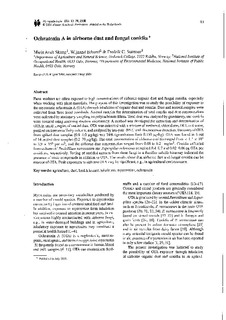Ochratoxin A in airborne dust and fungal conidia
Journal article, Peer reviewed

Åpne
Permanent lenke
http://hdl.handle.net/11250/134594Utgivelsesdato
2001Metadata
Vis full innførselSamlinger
Originalversjon
Skaug, M. A., Eduard, W. & Størmer, F. C. (2001). Ochratoxin A in airborne dust and fungal conidia. Mycopathologia 151(2), 93-98Sammendrag
Farm workers are often exposed to high concentrations of airborne organic dust and fungal conidia, especially when working with plant materials. The purpose of this investigation was to study the possibility of exposure to the mycotoxin ochratoxin A (OTA) through inhalation of organic dust and conidia. Dust and aerosol samples were collected from three local cowsheds. Aerosol samples for determination of total conidia and dust concentrations were collected by stationary sampling on polycarbonate filters. Total dust was analysed by gravimetry, and conidia were counted using scanning electron microscopy. A method was developed for extraction and determination of OTA in small samples of settled dust. OTA was extracted with a mixture of methanol, chloroform, HCl, and water, purified on immunoaffinity column, and analysed by ion-pair HPLC with fluorescence detection. Recovery of OTA from spiked dust samples (0.9-1.0 microg/kg) was 74% (quantitation limit 0.150 microg/kg). OTA was found in 6 out of 14 settled dust samples (0.2-70 microg/kg). The total concentration of airborne conidia ranged from < 1.1 x 10(4) to 3.9 x 15(5) per m3, and the airborne dust concentration ranged from 0.08 to 0.21 mg/m3. Conidia collected from cultures of Penicillium verrucosum and Aspergillus ochraceus contained 0.4-0.7 and 0.02-0.06 pg OTA per conidium, respectively. Testing of conidial extracts from these fungi in a Bacillus subtilis bioassay indicated the presence of toxic compounds in addition to OTA. The results show that airborne dust and fungal conidia can be sources of OTA. Peak exposures to airborne OTA may be significant, e.g., in agricultural environments.
Beskrivelse
Tidsskriftartikkel publisert i tidsskriftet Mycopathologia, 2001.